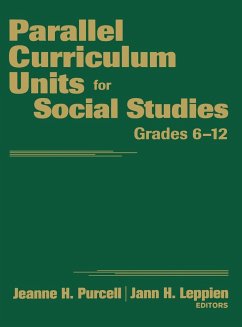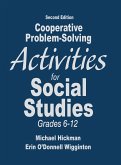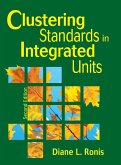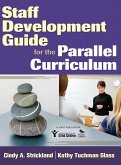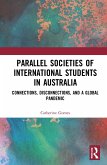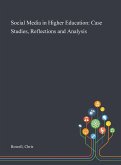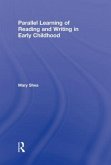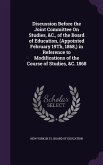Schade – dieser Artikel ist leider ausverkauft. Sobald wir wissen, ob und wann der Artikel wieder verfügbar ist, informieren wir Sie an dieser Stelle.
- Gebundenes Buch
- Merkliste
- Auf die Merkliste
- Bewerten Bewerten
- Teilen
- Produkt teilen
- Produkterinnerung
- Produkterinnerung
Covering history, geography, and sociology, these sample lessons and units show how to use the Parallel Curriculum Model to provide rigorous learning opportunities for students in social studies.
Andere Kunden interessierten sich auch für
![Cooperative Problem-Solving Activities for Social Studies, Grades 6-12 Cooperative Problem-Solving Activities for Social Studies, Grades 6-12]() Michael HickmanCooperative Problem-Solving Activities for Social Studies, Grades 6-1286,99 €
Michael HickmanCooperative Problem-Solving Activities for Social Studies, Grades 6-1286,99 €![Clustering Standards in Integrated Units Clustering Standards in Integrated Units]() Diane L. RonisClustering Standards in Integrated Units83,99 €
Diane L. RonisClustering Standards in Integrated Units83,99 €![Staff Development Guide for the Parallel Curriculum Staff Development Guide for the Parallel Curriculum]() Cindy A. StricklandStaff Development Guide for the Parallel Curriculum88,99 €
Cindy A. StricklandStaff Development Guide for the Parallel Curriculum88,99 €![Parallel Societies of International Students in Australia Parallel Societies of International Students in Australia]() Catherine GomesParallel Societies of International Students in Australia198,99 €
Catherine GomesParallel Societies of International Students in Australia198,99 €![Social Media in Higher Education: Case Studies, Reflections and Analysis Social Media in Higher Education: Case Studies, Reflections and Analysis]() Chris RowellSocial Media in Higher Education: Case Studies, Reflections and Analysis51,99 €
Chris RowellSocial Media in Higher Education: Case Studies, Reflections and Analysis51,99 €![Parallel Learning of Reading and Writing in Early Childhood Parallel Learning of Reading and Writing in Early Childhood]() Mary SheaParallel Learning of Reading and Writing in Early Childhood230,99 €
Mary SheaParallel Learning of Reading and Writing in Early Childhood230,99 €![Discussion Before the Joint Committee On Studies, &C., of the Board of Education, (Appointed February 19Th, 1868, ) in Reference to Modifications of t Discussion Before the Joint Committee On Studies, &C., of the Board of Education, (Appointed February 19Th, 1868, ) in Reference to Modifications of t]() Discussion Before the Joint Committee On Studies, &C., of the Board of Education, (Appointed February 19Th, 1868, ) in Reference to Modifications of t36,99 €
Discussion Before the Joint Committee On Studies, &C., of the Board of Education, (Appointed February 19Th, 1868, ) in Reference to Modifications of t36,99 €-
Covering history, geography, and sociology, these sample lessons and units show how to use the Parallel Curriculum Model to provide rigorous learning opportunities for students in social studies.
Produktdetails
- Produktdetails
- Verlag: Corwin
- Seitenzahl: 240
- Erscheinungstermin: 10. Dezember 2009
- Englisch
- Abmessung: 286mm x 221mm x 18mm
- Gewicht: 874g
- ISBN-13: 9781412965392
- ISBN-10: 141296539X
- Artikelnr.: 27936608
- Herstellerkennzeichnung
- Libri GmbH
- Europaallee 1
- 36244 Bad Hersfeld
- gpsr@libri.de
- Verlag: Corwin
- Seitenzahl: 240
- Erscheinungstermin: 10. Dezember 2009
- Englisch
- Abmessung: 286mm x 221mm x 18mm
- Gewicht: 874g
- ISBN-13: 9781412965392
- ISBN-10: 141296539X
- Artikelnr.: 27936608
- Herstellerkennzeichnung
- Libri GmbH
- Europaallee 1
- 36244 Bad Hersfeld
- gpsr@libri.de
Jeanne H. Purcell is the consultant to the Connecticut State Department of Education for gifted and talented education. She is also director of UConn Mentor Connection, a nationally recognized summer mentorship program for talented teenagers that is part of the NEAG Center for Talent Development at the University of Connecticut. Prior to her work at the State Department of Connecticut, she was an administrator for Rocky Hill Public Schools (CT); a program specialist with the National Research Center on the Gifted and Talented, where she worked collaboratively with other researchers on national issues related to high-achieving young people; an instructor of Teaching the Talented, a graduate-level program in gifted education; and a staff developer to school districts across the country and Canada. She has been an English teacher, community service coordinator, and teacher of the gifted, K-12, for 18 years in Connecticut school districts and has published many articles that have appeared in Educational Leadership, Gifted Child Quarterly, Roeper Review, Educational and Psychological Measurement, National Association of Secondary School Principals' Bulletin, Our Children: The National PTA Magazine, Parenting for High Potential, and Journal for the Education of the Gifted. She is active in the National Association for Gifted Children (NAGC) and serves on the Awards Committee and the Curriculum Committee of NAGC, for which she is the co-chair for the annual Curriculum Awards Competition.
About the Editors
About the Contributors
Introduction: A Brief History of the Parallel Curriculum Model (PCM)
1. Becoming a Geographer (Grade 6) - Heather Burke
Background Information
Content Framework
Unit Assessments
Overview of the Unit
Lesson 1: Climate and Seasons
Lesson 2: Investigating World Populations
Lesson 3: Shop Around the Globe
Lesson 4: The Culture of Geography
2. Through the Looking Glass: A Unit for Reading/Writing/Social Studies
Intervention Classes (Middle School) - Dawn Vier, Lisa L. Ward
Introduction to the Unit
Content Framework
Unit Assessments
Background Information
Unit Sequence, Description, and Teacher Reflections
Lesson 1: Introduction?"Who Am I?"
Lesson 2: The Pursuit of Happiness
Lesson 3: Authentic Authors
Lesson 4: Sociocentrism
Lesson 5: The City
Lesson 6: The Great Depression
Lesson 7: A Sign of the Times
Lesson 8: Persuade Me!
Lesson 9: Planet Earth
3. Subversion and Controversy: Sociological Considerations of Humor, a
Cross-Curricular Unit in Sociology and Literature (Grades 7 and 8) - Kelly
M. Dausel
Background Information
Content Framework
Guiding Questions for Each Parallel
Unit Assessments
Overview of the Unit
Unit Sequence, Description, and Teacher Reflections
Lesson 1: Introduction to Sociology and How Sociologists Think
Lesson 2: Humor in Society
Lesson 3: Humor in Communication
Lesson 4: Sociological Research
Lesson 5: Curriculum of Identity Creative Extension
4. True Story-Telling: How Historians Construct the Past, Grade 10 -
Catherine Little
Background Information
Content Framework
Unit Assessments
Overview of Key Lesson Ideas/Purposes
Lesson 1: Selective Memory
Lesson 2: Constructing History
Lesson 3: The Past Through Many Eyes
Lesson 4: Who Writes History?
Lesson 5: What Makes the History Books?
Resources
Index
About the Contributors
Introduction: A Brief History of the Parallel Curriculum Model (PCM)
1. Becoming a Geographer (Grade 6) - Heather Burke
Background Information
Content Framework
Unit Assessments
Overview of the Unit
Lesson 1: Climate and Seasons
Lesson 2: Investigating World Populations
Lesson 3: Shop Around the Globe
Lesson 4: The Culture of Geography
2. Through the Looking Glass: A Unit for Reading/Writing/Social Studies
Intervention Classes (Middle School) - Dawn Vier, Lisa L. Ward
Introduction to the Unit
Content Framework
Unit Assessments
Background Information
Unit Sequence, Description, and Teacher Reflections
Lesson 1: Introduction?"Who Am I?"
Lesson 2: The Pursuit of Happiness
Lesson 3: Authentic Authors
Lesson 4: Sociocentrism
Lesson 5: The City
Lesson 6: The Great Depression
Lesson 7: A Sign of the Times
Lesson 8: Persuade Me!
Lesson 9: Planet Earth
3. Subversion and Controversy: Sociological Considerations of Humor, a
Cross-Curricular Unit in Sociology and Literature (Grades 7 and 8) - Kelly
M. Dausel
Background Information
Content Framework
Guiding Questions for Each Parallel
Unit Assessments
Overview of the Unit
Unit Sequence, Description, and Teacher Reflections
Lesson 1: Introduction to Sociology and How Sociologists Think
Lesson 2: Humor in Society
Lesson 3: Humor in Communication
Lesson 4: Sociological Research
Lesson 5: Curriculum of Identity Creative Extension
4. True Story-Telling: How Historians Construct the Past, Grade 10 -
Catherine Little
Background Information
Content Framework
Unit Assessments
Overview of Key Lesson Ideas/Purposes
Lesson 1: Selective Memory
Lesson 2: Constructing History
Lesson 3: The Past Through Many Eyes
Lesson 4: Who Writes History?
Lesson 5: What Makes the History Books?
Resources
Index
About the Editors
About the Contributors
Introduction: A Brief History of the Parallel Curriculum Model (PCM)
1. Becoming a Geographer (Grade 6) - Heather Burke
Background Information
Content Framework
Unit Assessments
Overview of the Unit
Lesson 1: Climate and Seasons
Lesson 2: Investigating World Populations
Lesson 3: Shop Around the Globe
Lesson 4: The Culture of Geography
2. Through the Looking Glass: A Unit for Reading/Writing/Social Studies
Intervention Classes (Middle School) - Dawn Vier, Lisa L. Ward
Introduction to the Unit
Content Framework
Unit Assessments
Background Information
Unit Sequence, Description, and Teacher Reflections
Lesson 1: Introduction?"Who Am I?"
Lesson 2: The Pursuit of Happiness
Lesson 3: Authentic Authors
Lesson 4: Sociocentrism
Lesson 5: The City
Lesson 6: The Great Depression
Lesson 7: A Sign of the Times
Lesson 8: Persuade Me!
Lesson 9: Planet Earth
3. Subversion and Controversy: Sociological Considerations of Humor, a
Cross-Curricular Unit in Sociology and Literature (Grades 7 and 8) - Kelly
M. Dausel
Background Information
Content Framework
Guiding Questions for Each Parallel
Unit Assessments
Overview of the Unit
Unit Sequence, Description, and Teacher Reflections
Lesson 1: Introduction to Sociology and How Sociologists Think
Lesson 2: Humor in Society
Lesson 3: Humor in Communication
Lesson 4: Sociological Research
Lesson 5: Curriculum of Identity Creative Extension
4. True Story-Telling: How Historians Construct the Past, Grade 10 -
Catherine Little
Background Information
Content Framework
Unit Assessments
Overview of Key Lesson Ideas/Purposes
Lesson 1: Selective Memory
Lesson 2: Constructing History
Lesson 3: The Past Through Many Eyes
Lesson 4: Who Writes History?
Lesson 5: What Makes the History Books?
Resources
Index
About the Contributors
Introduction: A Brief History of the Parallel Curriculum Model (PCM)
1. Becoming a Geographer (Grade 6) - Heather Burke
Background Information
Content Framework
Unit Assessments
Overview of the Unit
Lesson 1: Climate and Seasons
Lesson 2: Investigating World Populations
Lesson 3: Shop Around the Globe
Lesson 4: The Culture of Geography
2. Through the Looking Glass: A Unit for Reading/Writing/Social Studies
Intervention Classes (Middle School) - Dawn Vier, Lisa L. Ward
Introduction to the Unit
Content Framework
Unit Assessments
Background Information
Unit Sequence, Description, and Teacher Reflections
Lesson 1: Introduction?"Who Am I?"
Lesson 2: The Pursuit of Happiness
Lesson 3: Authentic Authors
Lesson 4: Sociocentrism
Lesson 5: The City
Lesson 6: The Great Depression
Lesson 7: A Sign of the Times
Lesson 8: Persuade Me!
Lesson 9: Planet Earth
3. Subversion and Controversy: Sociological Considerations of Humor, a
Cross-Curricular Unit in Sociology and Literature (Grades 7 and 8) - Kelly
M. Dausel
Background Information
Content Framework
Guiding Questions for Each Parallel
Unit Assessments
Overview of the Unit
Unit Sequence, Description, and Teacher Reflections
Lesson 1: Introduction to Sociology and How Sociologists Think
Lesson 2: Humor in Society
Lesson 3: Humor in Communication
Lesson 4: Sociological Research
Lesson 5: Curriculum of Identity Creative Extension
4. True Story-Telling: How Historians Construct the Past, Grade 10 -
Catherine Little
Background Information
Content Framework
Unit Assessments
Overview of Key Lesson Ideas/Purposes
Lesson 1: Selective Memory
Lesson 2: Constructing History
Lesson 3: The Past Through Many Eyes
Lesson 4: Who Writes History?
Lesson 5: What Makes the History Books?
Resources
Index

